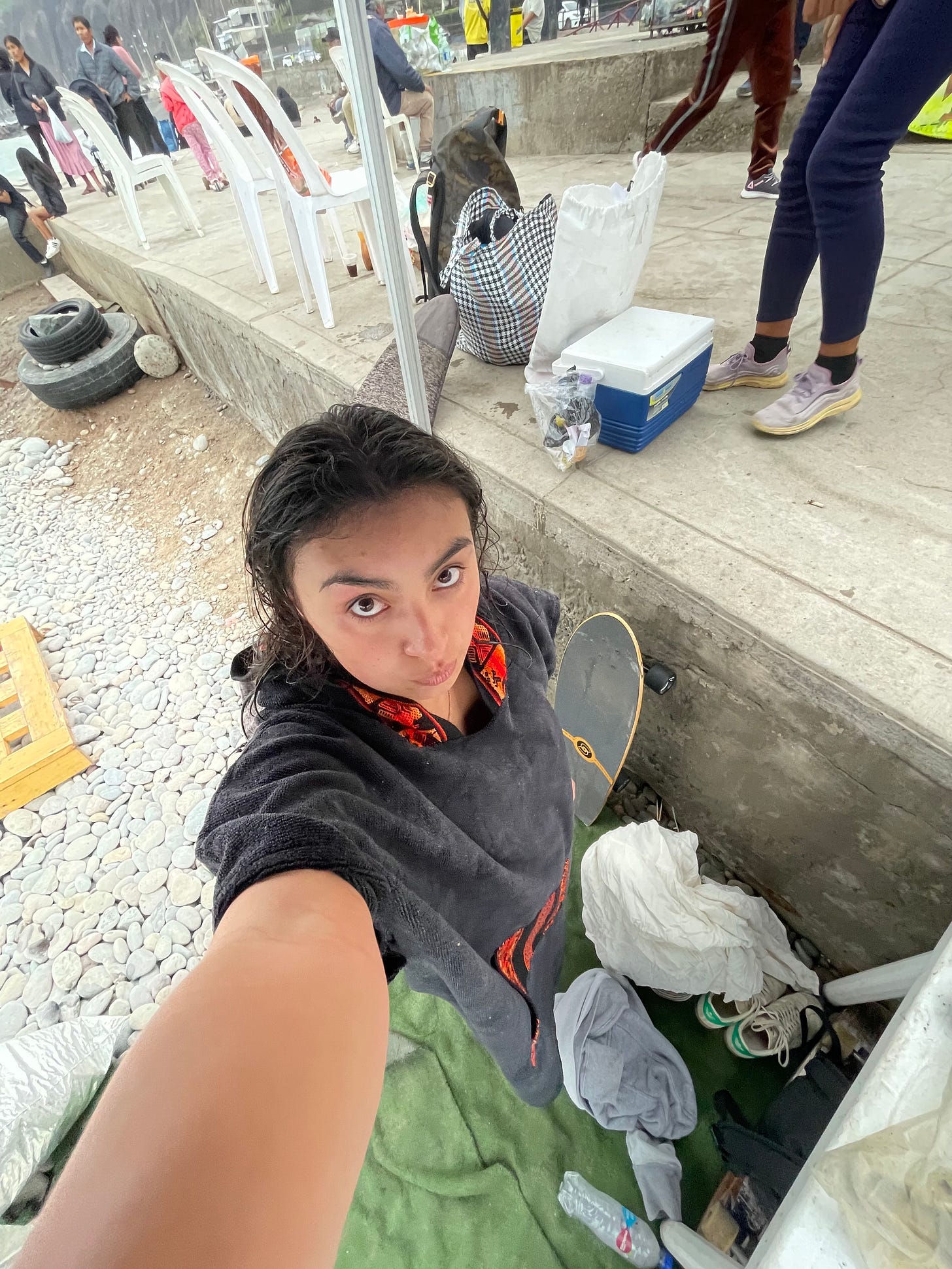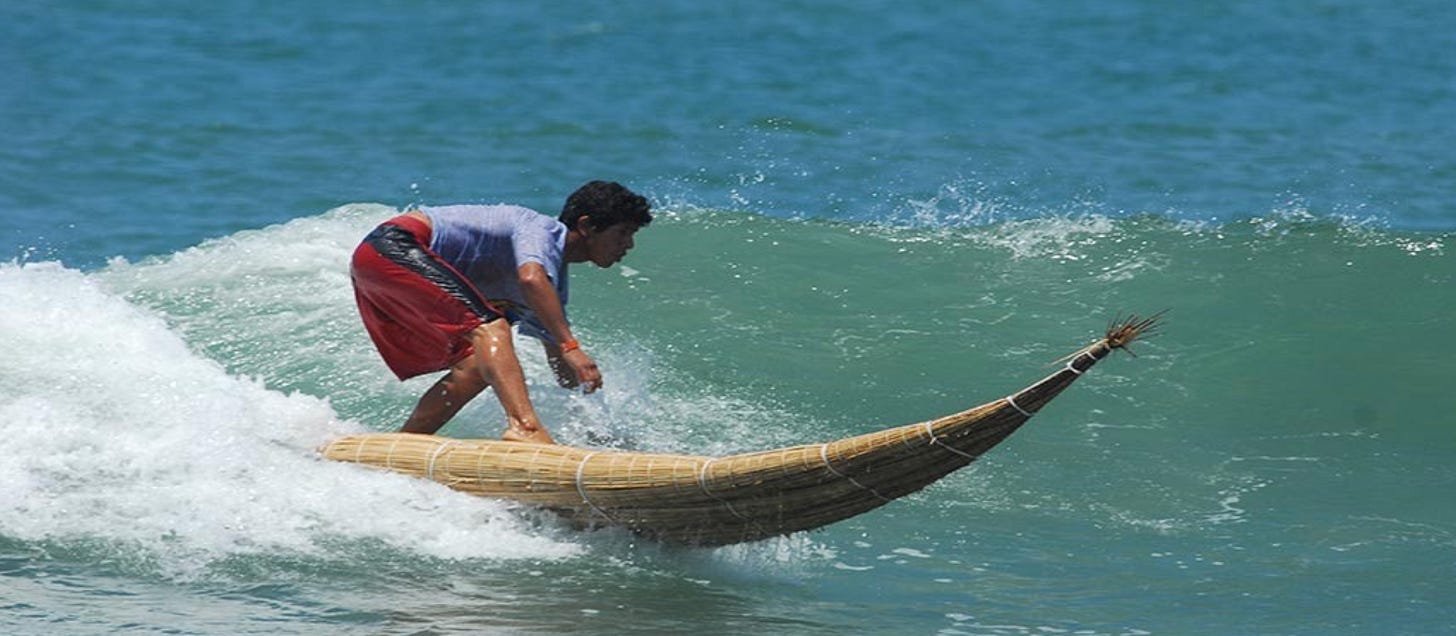Experience Blog 1
Hi baes!
Let me tell you about my little side quest of the day because I learned so much about indigeneity and surfing in Peru. While on a walk with some baes we reached the park above Makaha beach in Miraflores. I saw the sets rolling in and some sparse little dots huddling around the wave breaks (all slightly astigmatic due to my lack of my visual aids). I was unsure if I was going to surf today but as soon as I saw the break I was sauntering as fast as my wispy skirt would allow me to. As I did my half-blind wave check I was bombarded with questions of “senorita, quieres aprender a surfear?” from multiple surf dudes decked out in some rated ponchos to protect them from the swelling wind. The question obviously phrased under the assumption that I wasn’t a surfer was oddly comforting in the male-dominated sport that surfing can be. I asked around a few tents to see if they had the board length and volume I wanted for the relatively mellow but maneuverable waves while I gathered intel on the break to avoid having to use that travel insurance. I engaged in a mild haggle until all the dudes agreed to offer me the same price which was surprisingly easy but I was surprised there was no standardized price at the beach. After a quick orientation of the currents and entry/exit I was off! Managed to shred some gnar…. Until I got caught in a set and the gnar shredded me. Thankfully, I made a quick recovery. However, I wasn’t taking any chances so I decided to follow a wise looking man with kind eyes on the waves to avoid being in the break zone of the breach break. My slightly stalkerish behaviour eventually led to conversation and I started chatting this man up between waves. He gave me the lore on Peruvian surfing between waves…
It’s usually commonly agreed upon that surfing originated in Polynesia, but he told me that there’s theories that surfing actually originated in northern Peru with some Indigenous groups around 3000 years ago (crazy long ago!) as a means to go fishing. The surfboards were kind of reed based planks with an upturned bow (see pictures attached). There is evidence of contact between Polynesia and South America, and surfing was potentially something the Polynesians eventually took to Hawaii from these Indigenous groups.
I was so curious that we made plans to meet on the beach post-surf session so he could show me some pictures of the stuff he was mentioning. Outside the water we chatted some more, and after a couple good laughs I got hungry so I said goodbye. I was left thinking about how an indigenous practice has become mainstream, as good and bad. Positive that indigeneity is built into the social fabric of the city and hasn’t been eradicated. However, there’s the issue of lack of Indigenous credit given to the sport. Indigeneity in Lima is evident on the surface if one can be informed of the history as the indigenous presence is under-explained. Surfing in our time is a sport primarily for privileged white males (my wallet is well acquainted with the expensive part) who dominate narratives that credit them and sweep histories under the rug.
Lima has a relatively dry climate as one of the readings pointed out (and my rapidly dwindling chapstick has felt), which made me curious about the potential difficulty of growing food in the area. The pride I have felt from Peruvians when they offer food has been centred on fish, from which I got an impression that the area relies on seafaring. The use of surfing to catch sustenance is quite ingenious.
As I was looking back at the city from the waves, it seemed like the smooth, sharp cliffs were a retaining wall for Lima. A barrier that contains the city and limits its expansion. The geographical barrier separates the nature of the ocean with the constructed city, creating a lack of harmony between the natural and built environment. I think this tracks with the sentiments I felt wandering around Lima in its many iterations of built but never in harmony with its surroundings.
It was interesting to me that I was surfing at Makaha beach, which was named after a famous Hawaiian beach known for huge waves. As much as we’ve discussed Spanish colonialism so far, the use of the American names for beaches worries me for a present American imposition in Lima that has the potential to destroy land and make life more difficult for the locals (ironically, similar to what mainland USA has done to the indigenous people of Hawaii). The potential subjugation of Lima to external control seems like a recipe for exploitation. I’m left wondering if my participation as a tourist surfer is part of the problem (even though I try to be as respectful as possible in my interactions with the locals). To me, surfing is beautiful in how freeing it is to surrender myself to the forces of nature for my craft, and it's a reminder of the power of water in maintaining livelihoods and ways of life. But in my attempt to ground myself, am I inadvertently destroying livelihoods?
It was special to me that these locals shared their home break and stories with me. Learning about the history of one of my beloved pastimes was also long overdue, and has made me reflect on another example of Western narratives that are commonly accepted. I will cherish this lovely afternoon I had by myself and a point of reflection for the political and historical forces that shape the frivolous like surfing.





Okay slightly unrelated to the overall theme of your post but I would be remiss if I did not mention how in love I am with the imagery. I can 100% visualize your "wispy skirt" and the "social fabric of the city" Now back to your experience, I think one the best ways to engage with culture is by being an active participant, which is exactly what you did. You both metaphorically and literally threw yourself into the deep end and then graced us all with this knowledge because of it. I think the mention of Hawaii is particularly poignant for our group as well because of the controversy and problematic nature of the tourism there which locals rally against. Can't wait to see what shenanigans you get up to next!
Thanks for your summary and insights about the surf culture in Lima and i appreciate the reflections you provided on your role as contributing while simultaneously trying to experience the culture to its fullest. I went for a surf yesterday between classes and i had this feeling that we hadn’t gotten to really feel lima until connecting with the ocean. The ocean was there long before and will be there long after, driving the climate, cuisine, culture, and of course sport!